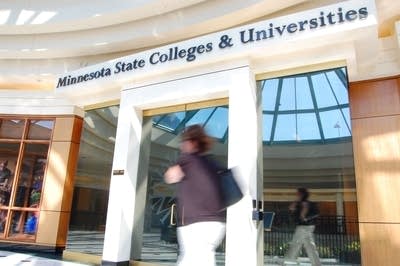Higher education sees big cut in Pawlenty plan

Governor Tim Pawlenty didn't use the word cut when he announced how higher education would fair under his proposal.
"We're going to give them this goal, this budget challenge and ask them to manage to it, and I think they're up to the challenge," Pawlenty said.
The challenge for colleges in Minnesota turns out to be $312 million less in funding than the last biennium. Higher education officials have a different phrase to describe the situation.

"It would be a severe cut to us," said Linda Kohl, a spokeswoman for the Minnesota State Colleges and Universities System.
Create a More Connected Minnesota
MPR News is your trusted resource for the news you need. With your support, MPR News brings accessible, courageous journalism and authentic conversation to everyone - free of paywalls and barriers. Your gift makes a difference.
The Governor's proposal would mean a $146 million cut in the MnSCU budget over the next two years.
If those numbers make it through the legislative session and land on MnSCU accountants' desks, Kohl said the system would likely need to lay off hundreds of employees, cut programs and classes, and close some MnSCU campuses.
"We're looking at everything. I don't think anything is off the table," Kohl said.
At the University of Minnesota, officials said they've been working to reduce their cost of operation over the last year. They've offered retirement incentives to reduce the work force, frozen executive salaries and left unfilled positions open.
U of M president Robert Bruininks said the University now has more work to do. The Governor's proposal would mean a $151 million cut to the U's two year budget.
"We're looking at strategies to curtail and cancel investments we felt were important and we're looking way to increase revenues from a variety of sources," Bruininks said.
Bruininks said the proposed higher education budget reductions, coupled with a $20 million budget unallotment that came from the governor just last month, are threatening the quality of the education the University can offer.
The quality of a Minnesota college education is also on the mind of Jacob Littler. Littler is taking online courses from several Minnesota colleges and he's also the student president of the Minnesota State College Student Association.
"You may [see] some other ways to make up that revenue, like layoffs and program cuts," Littler said. "It makes you wonder how that's going to affect you as a student."
Littler said students worry that cuts to colleges may result in a higher tuition bill.
Governor Tim Pawlenty has recommended the state's colleges keep any tuition increases at an inflationary level, perhaps in the neighborhood of 3 to 5 percent. MnSCU and the University of Minnesota are opposed to the tuition cap, but said increasing tuition is the last thing they want to do in a tough economy.
One part of the higher education budget that fared well under the Governor's plan is the State Grant program. The governor continued funding the $150 million a year program that helps lower income students pay for their college education at public or private colleges.
David Laird, the president of the Minnesota Private College Council, was pleased with that budget bright spot.
"This is a big step I think and a bold statement on the governor's part to say, 'We need to find a way to ensure that low and middle income students are still going to be able to make it through college,'" Laird said.
The money for the the State Grant program, Laird admits, is just a proposal at this point. But then, so are the reductions in funding. With that in mind, Minnesota higher education officials say they'll try to convince lawmakers in the coming months to soften the blow of budget cuts to Minnesota colleges.
